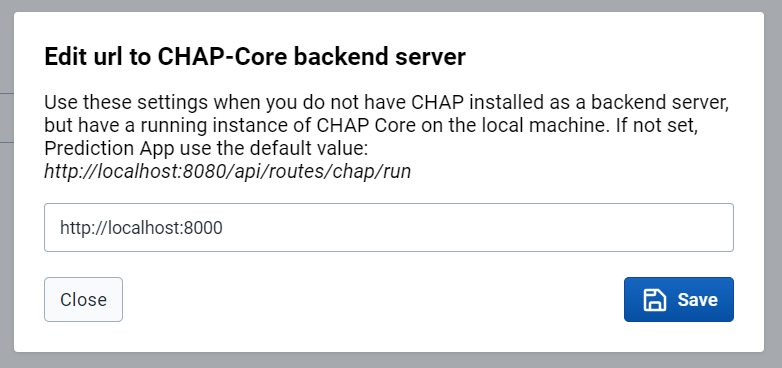Setting up CHAP Prediction App in DHIS2¶
This document describes how to install the Prediction App in your DHIS2 instance.
Requirements:
DHIS2 version 2.39+
1 Setting up CHAP-Core REST API¶
The Prediction App requires communication with an instance of the CHAP-Core REST-API. For using the Prediction App in a production environment, it’s recommended that the Chap REST-API has been set up on a permanent server by a system admin.
🛈 Alternatively, you can follow the instructions on how to setup a Chap REST-API locally using Docker.
Verify that you have access to the CHAP REST-API and that it’s running correctly, by visiting
<your-url-to-chap-server>/docs. A Swagger page (REST-API documentation) should display.🛈 If you’re running the REST-API as a local Docker container, verify by going to
http://localhost:8000/docs.
2 Download and Install Prediction App¶
Currently the Prediction App is not yet available on the DHIS2 App Hub. Until then you need to download the Prediction App as a ZIP file for installing it on your DHIS2 instance.
Download Prediction App from the versions available at https://github.com/dhis2/prediction-app/tree/refs/heads/main/build/bundle
Upload the ZIP file (Prediction App) to your DHIS2 instance (Learn how to install a custom DHIS2 app)
🛈 Alternatively for developers, you can run a local development version of the Prediction App as described here.
3 Configure CHAP Core URL¶
Finally, the Prediction App needs to know which URL to use to communicate with the CHAP Core REST-API. By clicking “Edit CHAP Core URL” located at the right side menu, a modal should display where you can configure this setting.
Set this value to <your-url-to-chap-server>.
🛈 If you’re running the REST-API as a local Docker container, this value should be set to
http://localhost:8000.

After clicking “Save”, Prediction App should reload and start to fetch and send data to the provided URL.